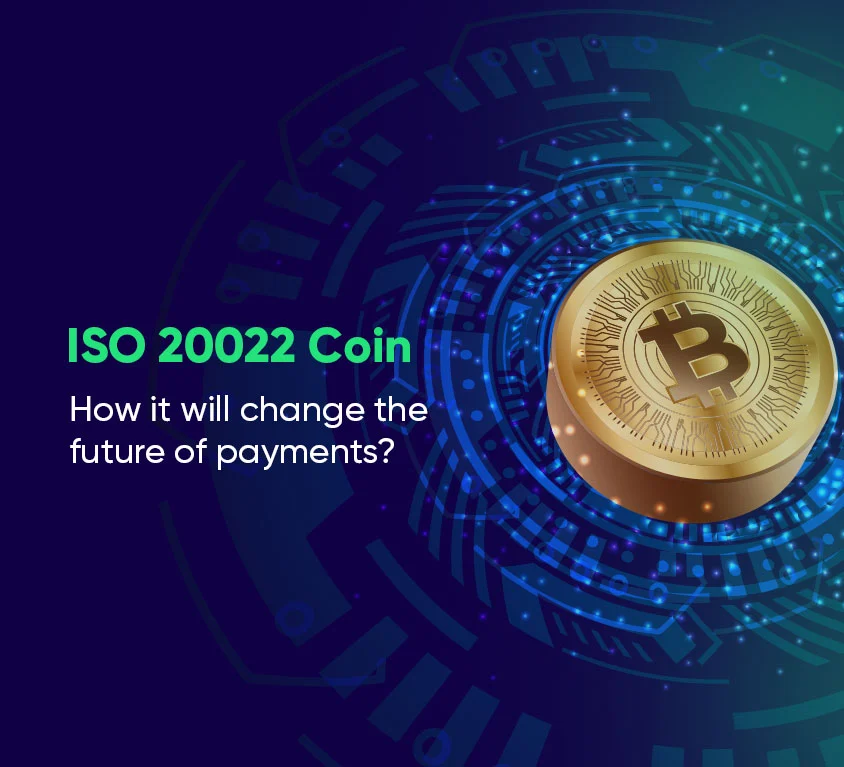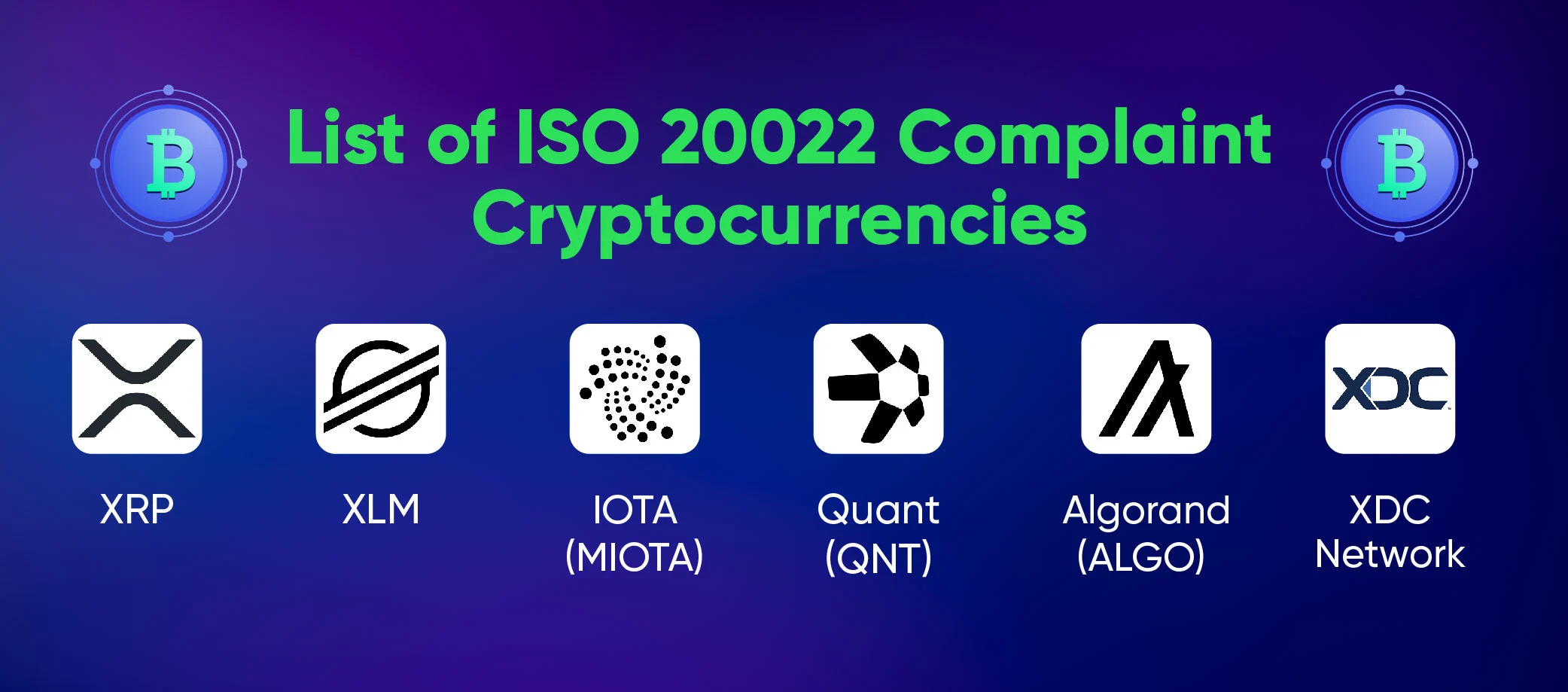
Introduction
Web3 & Blockchain Consultancy :
ISO 20022 Coins – A Detailed List of Compliant Cryptocurrencies
The ISO 20022 standard has gained significant importance in the financial sector as a unified framework for electronic data interchange among financial institutions. Originally designed for conventional financial transactions, this standard has now extended its reach to encompass the realm of cryptocurrencies. ISO 20022 introduces standardization and interoperability to the crypto industry, facilitating more seamless communication between different platforms and stakeholders. In this article, we will break down the potential benefits of ISO 20022 coins and identify major crypto projects who have adopted the standard.Key Takeaways
- ISO 20022 is a worldwide standard for financial messaging that ensures consistent data exchange between financial institutions.
- Its main goal is to update the traditional financial sector, making data handling simpler.
- The standard is being embraced by both traditional finance and cryptocurrencies to enhance compatibility.
- Cryptocurrency projects that use ISO 20022 can easily connect with traditional financial systems.
- Notable crypto projects that comply with ISO 20022 include XRP, Cardano, Quant, Algorand, Stellar, Hedera Hashgraph, IOTA, and XDC Network.
What is ISO 20022?
ISO 20022 is a global standard for financial messaging that creates a unified language and structure for electronic data exchange between financial institutions and international payment systems like SWIFT. The purpose of ISO 20022 is to replace the many different messaging formats and protocols used by financial systems with a single, standardized approach. This standardization of ISO 20022 helps financial institutions streamline operations, reduce complexity, and enhance the accuracy and reliability of data exchange. ISO 20022 crypto projects can easily integrate with traditional financial systems, bringing the benefits of blockchain immutability and decentralized data to the financial sector. However, not all institutions have adopted ISO 20022 yet. According to a recent Forbes report, about 72% of banks are compliant with ISO 20022. Institutions that have not yet made the necessary changes have until 2025 to comply. It’s also worth noting that the term “ISO 20022 compliant coin” might be misleading. The coin or token itself is not compliant; rather, the project uses elements of the messaging language defined by the standard to facilitate easier communication and data exchange between the project’s solutions (such as Ripple’s payment network) and external financial systems (like SWIFT).What are ISO 20022 Coins?
ISO 20022 coins are cryptocurrencies designed to comply with the ISO 20022 standard, a global framework for financial messaging. This standard aims to streamline and enhance the efficiency of electronic data exchange between financial institutions. By complying with ISO 20022, these cryptocurrencies can integrate more effectively with traditional financial systems, facilitating smoother communication and data interoperability. ISO 20022 compliant coins leverage the structured messaging format defined by ISO 20022 to ensure accurate and reliable data exchanges. This compliance helps bridge the gap between conventional financial networks and the world of digital assets, making it easier for banks and other financial entities to adopt and utilize these cryptocurrencies within their existing infrastructures.History of ISO 20022 Coins
The ISO 20022 standard was developed in the early 2000s to create a universal language for electronic financial communication. This standard replaces the older SWIFT/MT protocols still widely used in global banking. The transition to ISO 20022 is now happening globally, overseen by central authorities such as the European Central Bank. This migration is expected to be completed by 2025, as older networks are gradually phased out. Leading cryptocurrencies like XRP and Stellar, which focus on integration with traditional banking systems, were among the first to adopt ISO 20022 formats. This adoption enables them to connect seamlessly with existing financial infrastructure and payment systems that are being upgraded to this new standard.List of ISO 20022 Compliant Coins

-
XRP
XRP is one of the largest cryptocurrencies. It plays a significant role in global payments due to its speed, cost efficiency, and integration with traditional financial systems.
Ripple, the company behind XRP, has developed RippleNet, an enterprise blockchain network that allows banks and financial institutions to spend money internationally. Transactions on RippleNet settle in as little as 3-5 seconds.
In RippleNet, XRP serves as a “bridge currency,” providing the necessary liquidity for converting between fiat currencies. With this, the requirement for slow cross-border infrastructure like SWIFT gets eliminated.
By adopting the ISO 20022 standard, Ripple enhances the connection between the traditional banking system and modern blockchain technology, using XRP to facilitate transactions.
Key Benefits of XRP
-
- Much faster and cheaper than traditional remittance methods
- Can manage around 1,500 transactions per second
- Uses an efficient consensus mechanism
- Widely adopted by institutions through RippleNet
-
Cardano (ADA)
Cardano is a highly robust and scientifically-engineered blockchain network. It is designed to provide a secure and sustainable financial infrastructure.
After years of academic-driven development, Cardano launched smart contract functionality in 2021, leading to rapid growth in its DeFi ecosystem.
By adopting the ISO 20022 standard, Cardano ensures full compatibility between its advanced capabilities and traditional financial systems. This ensures seamless integration with existing banking technology and simplifies the onboarding of legacy institutions.
Key Benefits of Cardano
-
- Supports complex smart contract execution
- Expanding ecosystem of decentralized applications and DeFi offerings
- Uses the innovative Ouroboros proof-of-stake consensus protocol
- Strong market presence and active developer community
-
Quant (QNT)
Quant Network is an interoperability platform that simplifies the integration and communication between various distributed ledgers and existing enterprise systems.
Quant’s main product, Overledger, provides the protocol needed to support multi-chain applications. This ensures connectivity across diverse blockchain environments.
By incorporating ISO 20022 support, Quant enables developers to create decentralized solutions that are compatible with traditional financial messaging networks. This facilitates interchain and cross-industry collaboration.
Key Benefits of Quant
-
- Enables multi-chain communication through its communication layer
- High-performance with vast throughput capabilities
- Enterprise-ready standards and developer resources
- Decentralized governance by the Quant community
-
Algorand (ALGO)
Algorand is developing an advanced decentralized infrastructure for finance and beyond, with a focus on scalability, security, and mainstream adoption.
Created by MIT professor Silvio Micali, Algorand’s unique proof-of-stake consensus protocol offers a platform for real-world blockchain applications.
By adopting the ISO 20022 standard, Algorand ensures its compatibility with existing financial systems while maintaining its advanced features. This makes Algorand an attractive option for institutions looking to utilize next-generation financial technologies.
Key Benefits of Algorand
-
- Facilitates fast and affordable micropayments
- Supports advanced smart contracts and decentralized applications
- Utilizes an environmentally sustainable consensus mechanism
- Strong academic foundation and backing
-
Stellar (XLM)
Stellar is an open-source blockchain project aimed at creating a global financial network that is affordable, fast, and easy to use.
Stellar connects banks, payment systems, and individuals to enable quick and inexpensive currency transfers, especially for cross-border transactions and remittances.
By incorporating the ISO 20022 standard into its messaging and communication framework, Stellar ensures smooth interoperability between its advanced network and traditional financial systems.
Key Benefits of Stellar
-
- Faster and cheaper remittances
- Uses the unique Stellar Consensus Protocol
- Nonprofit organization focused on financial inclusion
- Native on-chain decentralized exchange
-
Hedera Hashgraph (HBAR)
Hedera provides an enterprise-grade distributed ledger for building secure, fair, and high-performance decentralized applications.
Utilizing the Hashgraph consensus for asynchronous Byzantine Fault Tolerance, Hedera offers extremely fast throughput while maintaining security. This enables institutions to develop compliant, real-world dApps and solutions.
By adopting ISO 20022, Hedera can integrate its advanced features into existing financial ecosystems, enhancing accessibility and trust for institutions using Hedera’s platform.
Key Benefits of Hedera
-
- Lightning-fast transactions, over 10,000 per second
- Robust security architecture
- Highly energy-efficient and sustainable
- Built-in token service and smart contracts
-
IOTA (MIOTA)
IOTA is developing an open-source distributed ledger tailored for the Internet of Things (IoT) ecosystem and machine-driven economies.
It uses a directed acyclic graph (DAG) architecture called the Tangle, focusing on secure and scalable transactions. The intuitive design allows easy data transfer between IoT devices.
By adopting the ISO 20022 standard, IOTA facilitates interoperability between connected devices on its network and external systems, bridging isolated IoT infrastructure to drive synergies and automation.
Key Benefits of IOTA
-
- Zero-fee microtransactions
- Quantum-proof cryptography
- Optimized for data and value transfer
- Lightweight and scalable architecture
-
XDC Network
XDC Network is a high-grade blockchain platform built for global trade and supply chain finance. Utilizing the XinFin Hybrid Blockchain protocol, it targets industries such as finance, supply chain, healthcare, and trade finance. The native token, XDC, is employed for both transactions and governance on the platform.
By adhering to the ISO 20022 standard, XDC Network improves its interoperability with traditional financial systems, providing a standardized framework for secure and efficient cross-border transactions. This integration places the network as a reliable solution for global trade, which is fully compliant.
Key Features of XDC Network
-
- Hybrid blockchain, combining benefits of public and private blockchains
- Can manage around 2,000 transactions per second
- Designed to comply with regulatory requirements
- Used for tracking the movement of goods and materials through supply chains
Why are ISO 20022 Coins Important?
ISO 20022 coins have the potential to significantly bridge the gap between cryptocurrencies and mainstream finance. BY adhering to globally recognized data standards among financial institutions, these digital assets unlock several key benefits:- Smoother integration with banking infrastructure – Compliant crypto coins can seamlessly interact with existing bank payment systems and settlement technologies, making it easier for them to be integrated into legacy financial systems.
- Interoperability with central bank digital currencies (CBDCs) – As major economies like China and the EU develop CBDCs, compatibility with ISO 20022 will be crucial. Coins that align with this standard are better positioned for future developments.
- Potential integration into the SWIFT system – Since SWIFT is widely used by banks around the world, integration with this system would greatly boost mainstream acceptance of cryptocurrencies. ISO 20022 compliance moves certain crypto coins closer to this goal.
- Bridge between fiat and crypto economies – Advanced data sharing between currency systems allows centralized and decentralized monetary networks to interact more efficiently, potentially accelerating crypto adoption.
- Essential for bank and institutional adoption – For banks to provide custody, trading, and widespread use of cryptocurrencies, seamless data functionality is mandatory. ISO 20022 is the leading industry standard for banks today.